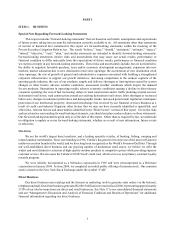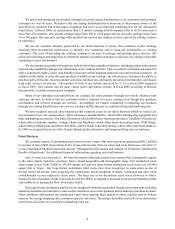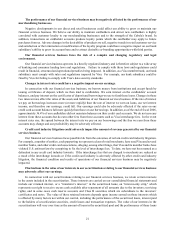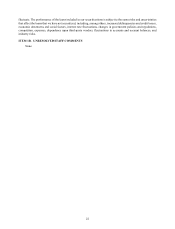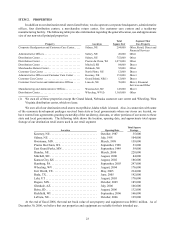Cabela's 2006 Annual Report Download - page 17
Download and view the complete annual report
Please find page 17 of the 2006 Cabela's annual report below. You can navigate through the pages in the report by either clicking on the pages listed below, or by using the keyword search tool below to find specific information within the annual report.13
Competition in the outdoor recreation and casual apparel and footwear markets could reduce our revenue
and profitability.
The outdoor recreation and casual apparel and footwear markets are highly fragmented and competitive. We
compete directly or indirectly with the following categories of companies:
• other specialty retailers that compete with us across a significant portion of our merchandising categories
through direct or retail businesses, such as Bass Pro Shops, Gander Mountain, Orvis, The Sportsman’s
Guide and Sportsman’s Warehouse;
• large-format sporting goods stores and chains, such as The Sports Authority, Dick’s Sporting Goods and
Big 5 Sporting Goods;
• retailers that currently compete with us through retail businesses that may enter the direct business;
• mass merchandisers, warehouse clubs, discount stores and department stores, such as Wal-Mart and
Target; and
• casual outdoor apparel and footwear retailers, such as L.L. Bean, Land’s End and REI.
Many of our competitors have a larger number of stores, and some of them have substantially greater market
presence, name recognition and financial, distribution, marketing and other resources than we have. In addition, if
our competitors reduce their prices, we may have to reduce our prices in order to compete. Furthermore, some of our
competitors have been aggressively building new stores in locations with high concentrations of our direct business
customers. As a result of this competition, we may need to spend more on advertising and promotion. Some of our
mass merchandising competitors, such as Wal-Mart, do not currently compete in many of the product lines we offer.
If these competitors were to begin offering a broader array of competing products, or if any of the other factors listed
above occurred, our revenue could be reduced or our costs could be increased, resulting in reduced profitability.
If we fail to maintain the strength and value of our brand, our revenue is likely to decline.
Our success depends on the value and strength of the Cabela’s brand. The Cabela’s name is integral to our
business as well as to the implementation of our strategies for expanding our business. Maintaining, promoting
and positioning our brand will depend largely on the success of our marketing and merchandising efforts and our
ability to provide high quality merchandise and a consistent, high quality customer experience. Our brand could be
adversely affected if we fail to achieve these objectives or if our public image or reputation were to be tarnished by
negative publicity. Any of these events could result in decreases in revenue.
We are implementing substantial systems changes in support of our direct business and destination retail
store expansion that might disrupt our supply chain operations.
Our success depends on our ability to source merchandise efficiently through appropriate management
information and operational systems and procedures. We regularly evaluate our information technology systems and
are implementing modifications to our technology that will involve updating or replacing our systems with successor
systems during the course of several years, including changes to our merchandising systems and improvements to
our customer relationship management system. There are inherent risks associated with replacing or modifying
these systems, including supply chain disruptions that could affect our ability to deliver products to our stores and
our customers in an efficient manner. In addition, in updating and replacing our systems, we may be unable to
accurately capture and transfer data. We may be unable to successfully launch these new systems, the launch of these
new systems could result in supply chain disruptions or the actual cost may exceed the estimated cost of these new
systems, any of which could have an adverse effect on our financial condition and results of operations. Additionally,
there is no assurance that successfully implemented new systems will deliver value to us.
We depend on vendors and service providers to operate our business and any disruption of their supply
of products and services could have an adverse impact on our revenue and profitability.
We depend on a number of vendors and service providers to operate our business, including:
• vendors to supply our merchandise in sufficient quantities at competitive prices in a timely manner;
• outside printers and catalog production vendors to print and mail our catalogs and to convert our catalogs
to digital format for website posting;


